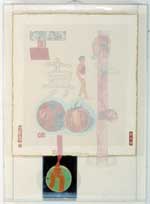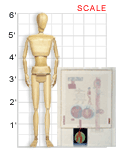VAM galleries including this work:
Jacobs Collection at Georgetown College | What’s in a Name? || VAM Home
Robert Rauschenberg (American, b. 1925)
7 CHARACTERS TRUTH, 1982
Silks, ribbons, and paper; 31" X 43"
Collection of Dr. and Mrs. Donald Jacobs—Art © Robert Rauschenberg/Licensed by VAGA, New York, NY
In 7 Characters Truth, Robert Rauschenberg incorporates visual icons and Chinese characters to force the viewer to ponder their meaning. The largest Chinese character cast into the paper means “sincerity.” The simplicity of forms; the balanced composition; the muted, red color scheme; and the gold border on the paper are all characteristics reminiscent of an Asian print.
About the Artist
Robert Rauschenberg is known for works of art constructed from the discards of urban civilization. His aptitude for and interest in art didn’t appear until he was in his 20s, when he used the G.I. Bill to study art in Paris. His interest in the European art scene faded quickly, and he moved to North Carolina and became involved with the ground-breaking artists associated with Black Mountain College, such as Joseph Albers, Buckminster Fuller, choreographer Merce Cunningham, and musician John Cage.
Drawn to the excitement of urban life, Rauschenberg moved to New York, where he began incorporating unusual materials into his paintings. His 1950s work highlighted his interest in popular culture over the seriousness of the Abstract Expressionists. With his 1955 work Bed, he began to incorporate complete objects into his large, abstract works. He termed the finished pieces “combines.”
According to Rauschenberg, the way in which he arranges seemingly unrelated objects in a chaotic manner is symbolic of the inexhaustible array of visual signs that surround us in an age of consumer culture and mass media. The viewer is forced to look at ordinary objects in an entirely different context.
With the advent of Pop Art in the ’60s, Rauschenberg began to explore printmaking, collage, and mixed media. He continues this experimentation today.
Classroom Ideas
Discussion: Do a visual inventory of 7 Characters Truth. Why might the artist have chosen red as the predominant color for this piece? How has he achieved a sense of balance in the composition? What does the title tell you about this work of art? Would you have guessed that an American artist created it? Why or why not?
Activity: Research a country to find symbols that represent it and create a composition using those symbols. Feel free to incorporate different materials and found objects into your artwork.
Links
Read an article about the life and work of Robert Rauschenberg and watch a video clip in which he discusses the origin of combines at the PBS American Masters web site.
[www.pbs.org/wnet/americanmasters/database/rauschenberg_r.html]
In 1988, the Guggenheim Museum showcased Rauschenberg’s influence on art with an exhibit of 400 works. Learn more about the artist at the Guggenheim Collection.
[www.guggenheimcollection.org/site/artist_bio_133.html]
Guides to more online resources about Rauschenberg are available in the Artcyclopedia and at The-Artists.org.
[www.artcyclopedia.com/artists/rauschenberg_robert.html]
[www.the-artists.org/ArtistView.cfm?id=239B640D-C5CF-11D4-A93800D0B7069B40]

